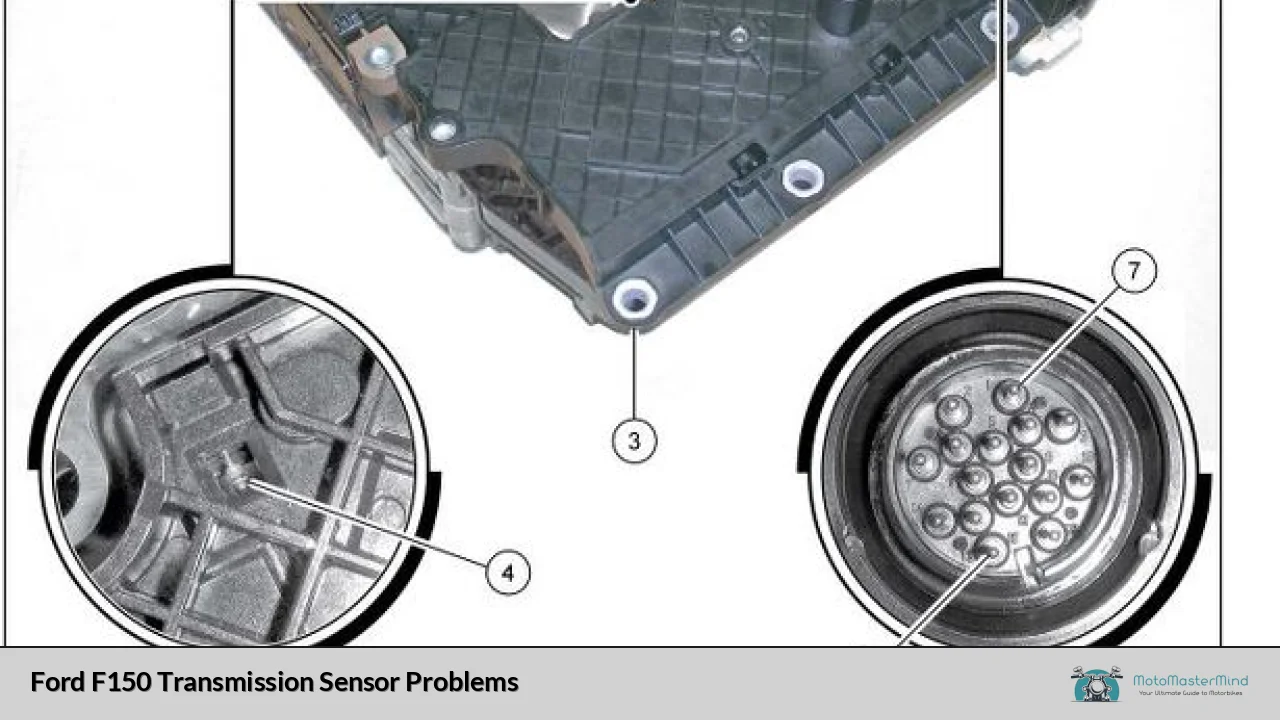Are you tired of dealing with transmission issues in your Ford F150? It can be frustrating when your truck’s transmission sensors start acting up, causing problems and affecting your driving experience. In this article, we will delve into the details of Ford F150 transmission sensor problems and explore some possible solutions.

One common issue that Ford F150 owners encounter is a faulty transmission speed sensor. This sensor is responsible for monitoring the rotational speed of the transmission output shaft, allowing the engine control module to adjust gear shifting accordingly. When the transmission speed sensor fails, it can lead to erratic shifting, harsh gear engagement, or even complete transmission failure. If you notice your F150 hesitating or jerking during gear changes, it could be an indication of a malfunctioning speed sensor.
Another troublesome sensor in the F150’s transmission system is the torque converter clutch (TCC) solenoid. The TCC solenoid controls the engagement and disengagement of the torque converter lock-up clutch, which improves fuel efficiency and reduces heat buildup. However, a faulty TCC solenoid can cause the clutch to engage at the wrong time or not disengage properly, resulting in symptoms like stalling when coming to a stop or excessive heat generation.
Additionally, the transmission range sensor (TRS), also known as the neutral safety switch, plays a crucial role in determining the position of the gear selector. It ensures that the vehicle starts only in Park or Neutral and prevents accidental starting in Drive or Reverse. A malfunctioning TRS can lead to incorrect gear selection, difficulty starting the engine, or even the inability to start the vehicle at all.
If you’re experiencing any of these issues with your Ford F150’s transmission sensors, it’s essential to have them diagnosed and repaired by a qualified mechanic. They can perform diagnostic tests using specialized equipment to pinpoint the exact cause of the problem. Depending on the severity of the issue, they may recommend replacing the faulty sensor or performing a complete transmission overhaul.
Ford F150 transmission sensor problems can cause significant disruptions to your driving experience. From faulty speed sensors to malfunctioning TCC solenoids and TRS issues, these sensor-related problems require prompt attention and professional repair. By addressing these concerns promptly, you can restore the smooth operation of your F150’s transmission and enjoy a worry-free driving experience.
Ford F150 Owners Face Growing Concerns Over Transmission Sensor Failures
Are you a proud owner of a Ford F150? Well, it’s time to pay attention to a growing concern that has been causing headaches for many F150 owners – transmission sensor failures. Yes, you heard it right. This issue has been gaining traction among the F150 community, and it’s essential to understand what it means for you and your beloved truck.
Imagine cruising down the road, feeling the power of your F150 beneath you, when suddenly you notice something is off. The gears start shifting erratically, or worse, you experience a complete loss of power. It’s frustrating and can be a real safety hazard. That’s where the transmission sensor comes into play.
The transmission sensor is a vital component of your F150’s transmission system. It’s responsible for monitoring various parameters, such as speed, temperature, and fluid levels, to ensure smooth gear shifts and overall optimal performance. However, a significant number of F150 owners have reported issues with these sensors failing prematurely.
So, why are these transmission sensors failing? There could be several reasons behind this problem. One possibility is a manufacturing defect, where certain batches of sensors may have been faulty from the beginning. Another potential cause could be the harsh driving conditions that many F150s are subjected to, such as towing heavy loads or off-roading.
Now, you might be wondering about the implications of a failed transmission sensor. Well, apart from the obvious inconvenience and potential safety risks, a malfunctioning sensor can lead to further damage to your transmission system if not addressed promptly. This could result in costly repairs or even the need for a complete transmission replacement.
If you’re experiencing any symptoms of a transmission sensor failure, such as rough shifting, delayed engagement, or warning lights on your dashboard, it’s crucial to take action. Reach out to your trusted mechanic or visit an authorized Ford service center to diagnose the issue and get it resolved before it escalates.
Ford F150 owners are facing growing concerns over transmission sensor failures. With these sensors playing a critical role in the smooth operation of your truck’s transmission system, it’s essential to be aware of the symptoms and take immediate action if you suspect any issues. Remember, addressing the problem early can save you from more significant headaches down the road. Keep an eye on your F150, and enjoy the thrill of driving with peace of mind.
The Hidden Culprit: Exploring the Troubling Rise of Ford F150 Transmission Sensor Issues

The Ford F150 has long been a symbol of American strength and reliability. With its powerful engine and rugged capabilities, it has won the hearts of truck enthusiasts across the country. However, beneath its formidable exterior lies a hidden culprit that has been causing trouble for many F150 owners: transmission sensor issues.
In recent years, there has been a troubling rise in reports of transmission sensor problems with the Ford F150. These sensors play a crucial role in ensuring smooth gear shifts and optimal performance. When they malfunction, it can lead to a host of issues, ranging from erratic shifting to complete transmission failure.
One of the most common symptoms of a faulty transmission sensor is the dreaded “check engine” light. When this light illuminates on the dashboard, it serves as a warning sign that something is amiss. In the case of transmission sensor problems, the root cause is often an electrical malfunction or a worn-out sensor.
Drivers have reported various issues related to these faulty sensors. Some experience harsh or delayed shifting, while others complain of the transmission getting stuck in a particular gear. Imagine the frustration of accelerating onto a highway, only to find your truck struggling to shift gears smoothly. It not only affects the driving experience but also raises concerns about safety.
The troubling rise of Ford F150 transmission sensor issues has left many owners seeking answers. Some have turned to dealerships for repairs, only to face hefty bills for sensor replacements and labor costs. Others have sought independent mechanics who specialize in transmission repairs.
As a Ford F150 owner, it’s important to stay informed about these issues and take proactive measures to address them. Regular maintenance and routine check-ups can help detect early signs of sensor problems before they escalate into more significant issues. Additionally, familiarizing yourself with the symptoms of a failing transmission sensor can help you identify the problem early on.
The rise of Ford F150 transmission sensor issues is a concerning trend that demands attention. As an owner, it’s crucial to be aware of the symptoms and take prompt action if you suspect a problem. By staying informed and proactive, you can help ensure that your F150 continues to perform at its best for years to come.
Breaking Down the Impact: How Ford F150 Transmission Sensor Problems Affect Drivers
Introduction: Imagine cruising down the highway in your Ford F150, wind in your hair and a sense of freedom embracing you. Suddenly, your vehicle jerks uncontrollably, leaving you stranded on the roadside. You’re not alone. Many Ford F150 drivers have experienced similar issues stemming from transmission sensor problems. In this article, we will delve into the impact these problems have on drivers, unraveling the complexities behind the scenes.
Unveiling the Transmission Sensor: The transmission sensor acts as the vital link between your F150’s engine and its transmission system. It detects and relays crucial data to ensure smooth gear shifting, efficient performance, and overall driving experience. However, when this sensor malfunctions, it sets off a chain reaction of issues that can dramatically affect your journey.
Loss of Power and Performance: One of the primary consequences of a faulty transmission sensor is a loss of power and performance in your F150. As the sensor fails to accurately monitor the speed and position of various components within the transmission system, the engine may struggle to shift gears smoothly. This leads to sluggish acceleration, reduced fuel efficiency, and an overall diminished driving experience.
Erratic Gear Shifting: A malfunctioning transmission sensor can wreak havoc on your F150’s gear shifting mechanism. Abrupt and erratic shifts between gears become common, causing jolts and jerks that can startle both the driver and passengers. Not only does this compromise safety, but it also puts unnecessary strain on other critical components of your vehicle’s drivetrain, potentially leading to further damage and costly repairs.

Transmission Overheating: In some cases, a defective transmission sensor can cause the transmission fluid to overheat. When the sensor fails to provide accurate temperature readings, the fluid may not receive proper cooling, leading to excessive heat buildup. Overheating can significantly reduce the lifespan of your transmission, resulting in expensive repairs or even a complete transmission failure.
Conclusion: The impact of Ford F150 transmission sensor problems on drivers is undeniable. The loss of power and performance, coupled with erratic gear shifting and the risk of transmission overheating, can turn an enjoyable ride into a frustrating ordeal. If you experience any symptoms associated with transmission sensor issues, it is crucial to have your vehicle inspected by a qualified technician promptly. By addressing these problems early on, you can ensure a safer, smoother, and more enjoyable driving experience in your Ford F150 for years to come.
From Gear Shifts to Headaches: Unveiling the Complexities of Ford F150 Transmission Sensor Malfunctions
Introduction: Have you ever experienced the frustration of gear shifting issues in your beloved Ford F150? If so, you’re not alone. The smooth functioning of a vehicle’s transmission system is crucial for an enjoyable driving experience. However, when transmission sensor malfunctions occur, it can quickly turn your ride into a bumpy and headache-inducing affair. In this article, we’ll delve into the complexities surrounding Ford F150 transmission sensor malfunctions, exploring their causes, symptoms, and potential solutions.
Uncovering the Culprits: Transmission sensor malfunctions in the Ford F150 can arise from various sources. One common culprit is a faulty speed sensor. This critical component monitors the rotational speed of the transmission, allowing the engine control module (ECM) to adjust gear shifts accordingly. When the speed sensor fails, erratic shifting, delayed engagement, and even total transmission failure may occur.
Another potential offender is the throttle position sensor (TPS). Responsible for detecting the position of the throttle plate, the TPS communicates vital information to the ECM, enabling precise gear changes. A malfunctioning TPS can lead to rough shifting, stalling, or unresponsive acceleration.
Recognizing the Warning Signs: Spotting the early signs of transmission sensor malfunctions can save you from costly repairs down the road. Keep an eye out for indicators such as illuminated check engine lights, inconsistent RPM readings, or abrupt gear changes without driver input. Additionally, if you notice your F150 experiencing difficulty shifting gears smoothly, slipping out of gear, or displaying a loss of power, it’s time to investigate further.
Addressing the Challenges: Once you’ve identified potential transmission sensor issues, seeking professional assistance is crucial. Expert technicians will employ advanced diagnostic tools to pinpoint the exact cause of the problem. From there, they can recommend appropriate actions, which may include sensor replacement or reprogramming.
In some cases, ongoing maintenance can prevent transmission sensor malfunctions. Regularly checking and replacing transmission fluid, as well as adhering to the manufacturer’s recommended service intervals, can enhance the longevity of your F150’s transmission system.
Conclusion: The complexities surrounding Ford F150 transmission sensor malfunctions can be perplexing, but understanding their causes and symptoms is the first step towards a resolution. By maintaining vigilance and promptly addressing any signs of trouble, you can keep your F150 running smoothly and ensure a headache-free driving experience. So, the next time you encounter gear shifting issues, remember that a thorough investigation into the transmission sensor might just save the day.

